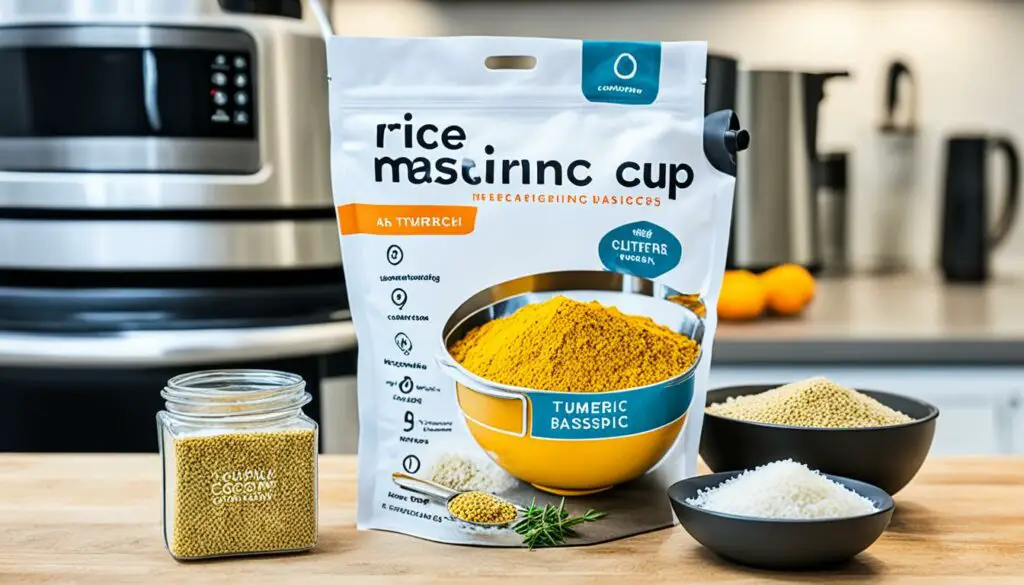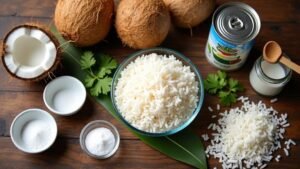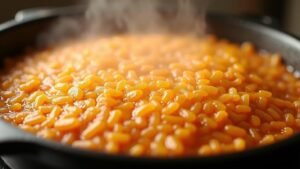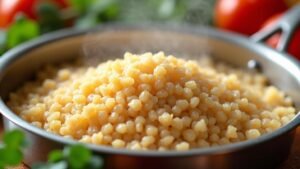Imagine the comforting smell of fluffy yellow rice wafting through your kitchen. The vibrant color, the aromatic spices, the flavorful taste – it’s a dish that never fails to bring a smile to my face. Yellow rice is more than just a meal – it’s a link to my cultural heritage, a reminder of family gatherings and shared moments of joy.
In this article, I’ll guide you through the process of making delicious yellow rice using a rice cooker. Whether you’re a seasoned cook looking to add a new recipe to your repertoire or a beginner eager to explore the world of flavorful rice dishes, this guide is for you. Get ready to embark on a culinary adventure that will leave your taste buds craving for more!
So let’s dive in and discover the secrets to making mouthwatering yellow rice that will elevate your meals and warm your soul.
Table of Contents
Introduction to Yellow Rice and Its Variations
Yellow rice, like its colorful counterpart red rice (which, incidentally, I have a whole post on here) is a popular and versatile dish enjoyed in many cultures around the world. Its vibrant color and distinct flavor make it a favorite among both children and adults. Yellow rice is a delightful addition to any meal, whether it’s served alongside grilled meats, stews, or on its own as a flavorful side dish.
The origins of yellow rice can be traced back to ancient civilizations that used various techniques to create the distinctive yellow color. In different cultures, yellow rice holds cultural significance and is often prepared during festive occasions and celebrations.
Yellow rice comes in different types and variations, each with its own unique characteristics and preparation methods. Here are some of the most popular types of yellow rice:
- Traditional Yellow Rice: This type of yellow rice is typically made with a combination of rice, spices, and often includes ingredients like turmeric, saffron, and annatto. It is a staple in many Asian, Middle Eastern, and Latin American cuisines.
- Saffron Yellow Rice: Saffron, known for its delicate yet distinct flavor and beautiful yellow color, is the key ingredient in saffron yellow rice. This type of yellow rice is often associated with high-end or festive meals.
- Coconut Yellow Rice: In some Southeast Asian cuisines, yellow rice is made by combining rice with coconut milk and spices, resulting in a creamy and aromatic dish that pairs well with spicy curries and grilled meats.
- Spicy Yellow Rice: For those who enjoy a bit of heat, spicy yellow rice is a fantastic choice. It incorporates chili peppers, jalapenos, or other spicy ingredients to add a kick to the dish.
Each variation of yellow rice boasts its own unique flavors and textures, allowing you to explore different culinary experiences. Whether you prefer the classic combination of spices or want to experiment with bold flavors, there is a type of yellow rice that will satisfy your taste buds.
| Type of Yellow Rice | Key Ingredients | Cultural Significance |
|---|---|---|
| Traditional Yellow Rice | Rice, turmeric, saffron, annatto | Commonly prepared for festive occasions |
| Saffron Yellow Rice | Rice, saffron | Often associated with high-end or celebratory meals |
| Coconut Yellow Rice | Rice, coconut milk, spices | Popular in Southeast Asian cuisines |
| Spicy Yellow Rice | Rice, chili peppers, jalapenos | Offers a spicy kick to the dish |
Exploring the different types of yellow rice allows you to appreciate the culinary diversity and cultural significance associated with this beloved dish. Whether you’re cooking a traditional recipe or adding your own twist, yellow rice is sure to bring a burst of color and flavor to your table.
The Best Rice for Making Flavorful Yellow Rice
The type of rice used can greatly affect the taste and texture of yellow rice. When it comes to making the best yellow rice, two popular rice grains come to mind: basmati rice and long grain rice. Let’s take a closer look at these grains and understand their qualities.
Choosing the Right Grain: Basmati vs. Long Grain
Basmati rice and long grain rice both have unique characteristics that make them suitable for yellow rice. Basmati rice is a fragrant rice variety known for its long, slender grains and distinct aroma. It originates from India and Pakistan and is widely used in Indian, Middle Eastern, and South Asian cuisines. The delicate, nutty flavor of basmati rice complements the spices and seasonings in yellow rice, resulting in a flavorful dish.
On the other hand, long grain rice, such as jasmine or Carolina rice, has a more neutral flavor and slightly shorter grains compared to basmati rice. It tends to yield lighter and fluffier rice, making it a popular choice for yellow rice in Latin American and Caribbean cuisines.
The Importance of Rinsing Your Rice
Rinsing rice before cooking is an essential step that should not be overlooked. When rice is harvested and processed, it can accumulate starch, debris, and other impurities. Rinsing rice helps remove these impurities and excess starch, resulting in fluffy and separate grains of rice.
To rinse rice properly, place the desired amount of rice in a fine-mesh sieve or colander. Rinse it under cold running water while gently agitating the grains with your fingers. Continue rinsing until the water runs clear, indicating that most of the starch has been removed. Once rinsed, drain the rice well before cooking.
By choosing the right rice grain and rinsing it before cooking, you can ensure that your yellow rice turns out flavorful, aromatic, and perfectly cooked. In the next section, we will delve into the essential ingredients that contribute to the vibrant yellow color and taste of this beloved rice dish.
Essential Ingredients for Authentic Yellow Rice
Spices and Seasonings: Saffron, Turmeric, and Annatto
To achieve the vibrant yellow color and aromatic flavor that defines yellow rice, a combination of spices and seasonings is essential. The three primary ingredients that contribute to the distinct yellow hue are saffron, turmeric, and annatto.
Saffron is a prized spice known for its rich color and delicate floral flavor. It adds a subtle complexity to yellow rice and is often used in small quantities due to its high cost.
Turmeric, a staple in many spice cabinets, provides a bright yellow color and a warm, earthy taste. It is widely used in yellow rice recipes and is known for its anti-inflammatory properties.
Annatto, derived from the seeds of the achiote tree, gives yellow rice its intense yellow-orange color. It has a mild peppery flavor and adds depth to the overall taste of the dish.
These spices work together harmoniously, creating the signature color and flavor of authentic yellow rice. Adjust the quantities according to your personal preference, keeping in mind that a little goes a long way.
Enhancing Taste with Chicken Stock and Other Broths
In addition to the spices, the choice of liquid used to cook yellow rice is crucial for developing its rich flavor. While water can be used, using chicken stock or other flavorful broths can take your yellow rice to another level.
Chicken stock provides a savory and meaty taste, enhancing the overall flavor profile of the rice. The natural umami from the stock adds depth and richness, making each bite more satisfying.
Alternatively, you can use other broths such as vegetable broth or seafood broth to infuse different flavors into the rice. For example, using seafood broth can create a deliciously fragrant yellow rice that pairs perfectly with seafood dishes.
When cooking the rice, substitute the water with your choice of broth to elevate the taste of yellow rice and make it even more enjoyable.
How to Make Yellow Rice in a Rice Cooker
Making yellow rice in a rice cooker is a convenient and hassle-free way to achieve perfectly cooked grains with vibrant flavors. Whether you’re preparing a quick weeknight dinner or hosting a special gathering, a rice cooker can be your secret weapon for delicious yellow rice. Follow these step-by-step instructions to create a mouthwatering yellow rice recipe using a rice cooker:
- Ingredients:
- 2 cups of long grain rice
- 1 teaspoon of turmeric
- 1/2 teaspoon of saffron threads
- 4 cups of water or chicken broth
- 1 tablespoon of vegetable oil
- Salt to taste
- Instructions:
- Rinse the rice thoroughly under cold water until the water runs clear. This helps remove any excess starch and ensures fluffy grains.
- Place the rinsed rice in the rice cooker’s inner pot.
- Add the turmeric and saffron threads to the rice, distributing them evenly.
- Pour in the water or chicken broth. If you prefer a richer flavor, opt for chicken broth.
- Add the vegetable oil and a pinch of salt for seasoning.
- Give the mixture a gentle stir to incorporate the spices and oil.
- Cover the rice cooker and set it to the “Cook” or “Rice” mode.
- Allow the rice to cook undisturbed until the cooker automatically switches to the “Keep Warm” mode. This usually takes about 20-25 minutes, depending on your rice cooker.
- Once the rice is cooked, fluff it gently with a fork to separate the grains.
- Serving:
- Yellow rice pairs well with a variety of dishes, such as grilled chicken, beef, seafood, or vegetarian stir-fries.
- Garnish with fresh herbs like parsley or cilantro for added freshness and color.
- Enjoy the aromatic and flavorful yellow rice straight from the rice cooker!
With this simple recipe, you can master the art of making yellow rice in a rice cooker. The result is fluffy, fragrant, and vibrant yellow rice that will impress your family and guests. Give it a try and elevate your rice-cooking game!
Step-by-Step Cooking Instructions for Homemade Yellow Rice
In this section, we will dive deeper into the step-by-step cooking instructions for preparing delicious homemade yellow rice. Follow these simple techniques and achieve perfectly cooked, flavorful yellow rice every time.
Preparing the Rice: Washing and Draining Techniques
Before cooking the rice, it is essential to wash it to remove any excess starch. This step will help prevent clumping and ensure fluffy grains of yellow rice. Follow these steps to prepare the rice:
- Measure the desired amount of rice and place it in a fine-mesh colander or strainer.
- Rinse the rice under cold water, gently rubbing the grains with your fingers to remove the starch. Continue rinsing until the water runs clear.
- After rinsing, transfer the washed rice into a separate bowl.
- Fill the bowl with cold water, covering the rice completely.
- Allow the rice to soak for about 30 minutes. This soaking process helps the rice absorb water evenly and ensures even cooking.
- After soaking, drain the rice using a colander or strainer, removing any excess water.
Mixing in Spices for Even Flavor Distribution
To achieve a well-balanced and flavorful yellow rice, it is important to mix in the spices properly. Here’s how you can ensure even distribution of flavors:
- In a small bowl, combine the spices for yellow rice, such as saffron, turmeric, and annatto.
- Once the rice is cooked and still hot, transfer it to a mixing bowl.
- Sprinkle the spice mixture evenly over the cooked rice.
- Gently mix the rice and spices together, using a fork or a spatula. Ensure that all grains are coated with the vibrant yellow color and aromatic spices.
By following these steps, you will be able to prepare the rice and mix in the spices to create a flavorful and vibrant yellow rice dish.
Additional Tips for Making Fluffy and Aromatic Yellow Rice
Achieving the perfect texture and aroma in yellow rice requires some additional tips and tricks. Follow these expert tips to take your yellow rice to the next level:
- Use chicken stock: Instead of cooking yellow rice in plain water, use chicken stock for added flavor. The rich flavor of the stock will enhance the overall taste of the rice.
- Adjust the water ratio: Yellow rice requires a specific water-to-rice ratio for optimal results. Follow the instructions on your rice cooker or adjust the water ratio to achieve a fluffy and perfectly cooked texture.
- Infuse the rice: To enhance the fragrance of yellow rice, consider infusing the rice with additional aromatics. You can add a few whole cloves, star anise, or cinnamon sticks to the water while cooking the rice.
- Let it steam: After the rice is cooked, allow it to sit in the rice cooker for a few minutes with the lid closed. This step is essential for achieving a fluffy texture and allows any excess moisture to evaporate.
By incorporating these tips into your yellow rice cooking process, you’ll be able to enjoy fluffy and aromatic yellow rice with every batch. Take your time and experiment with different flavors and techniques to find the perfect combination for your taste buds.

Storing and Reheating Your Yellow Rice
If you have leftovers or want to make yellow rice in advance, it’s important to know how to properly store and reheat it to preserve its flavor and texture. Follow these guidelines to ensure your yellow rice remains delicious even after storing and reheating:
Storing Yellow Rice:
- Allow the yellow rice to cool down to room temperature before storing.
- Transfer the yellow rice to an airtight container or a sealed plastic bag.
- Label the container with the date to keep track of its freshness.
- Store the yellow rice in the refrigerator for up to 3-4 days.
Reheating Yellow Rice:
When reheating yellow rice, it’s essential to avoid drying it out or compromising its flavor. Here are two recommended methods:
- Reheating in the Microwave:
- Place the desired amount of yellow rice in a microwave-safe dish.
- Add a small amount of water or chicken broth to the dish to help retain moisture.
- Cover the dish with a microwave-safe lid or microwave-safe plastic wrap, leaving a small vent for steam to escape.
- Heat the yellow rice in the microwave in 30-second intervals, stirring in between, until it reaches the desired temperature.
- Fluff the reheated yellow rice with a fork before serving.
- Reheating on the Stovetop:
- In a saucepan, add a small amount of water or chicken broth.
- Bring the liquid to a simmer over medium heat.
- Add the yellow rice to the saucepan and stir gently to distribute the heat.
- Continue simmering, stirring occasionally, until the yellow rice is heated through.
- Fluff the reheated yellow rice with a fork before serving.
By following these storage and reheating guidelines, you can enjoy the delicious flavor and texture of your yellow rice even when it’s not freshly cooked. Now let’s move on to the conclusion and recap of the yellow rice recipe.
Conclusion
In conclusion, making delicious yellow rice in a rice cooker is a breeze. By following our step-by-step guide, you can achieve perfectly cooked and flavorful yellow rice every time.
Throughout this article, we explored the origins and cultural significance of yellow rice, discussed the best rice grains to use, and highlighted the essential ingredients for authentic flavor. We provided detailed cooking instructions, including tips for achieving a fluffy and aromatic texture.
Remember to store any leftovers properly to preserve the flavor and texture of your yellow rice. With these insights and our recipe, you are well-equipped to create a mouthwatering yellow rice dish that will impress your family and guests.
FAQ
How do you make yellow rice in a rice cooker?
Making yellow rice in a rice cooker is easy. Simply follow our step-by-step guide for perfectly cooked and flavorful yellow rice every time.
What are the different types and variations of yellow rice?
Yellow rice can be found in various cuisines and has different types and variations. Explore the origins and cultural significance of yellow rice in this section.
Should I use basmati rice or long grain rice for yellow rice?
Learn about the differences between basmati rice and long grain rice and discover which one is the best choice for making flavorful yellow rice.
Why is it important to rinse rice before cooking?
Find out why rinsing rice before cooking is essential and how it can improve the taste and texture of your yellow rice.
What are the key spices and seasonings used in yellow rice?
Explore the essential spices and seasonings used in yellow rice, such as saffron, turmeric, and annatto, to achieve authentic and flavorful results.
How can I enhance the taste of yellow rice with chicken stock or other broths?
Discover how chicken stock and other broths can enhance the flavor of your yellow rice and learn how to incorporate them into your recipe.
What are the step-by-step instructions for making yellow rice in a rice cooker?
Follow our detailed guide for making yellow rice in a rice cooker and enjoy the convenience of perfectly cooked yellow rice.
How do I prepare the rice for making homemade yellow rice?
Learn the techniques for preparing the rice, including washing and draining, to achieve the perfect texture and flavor in your homemade yellow rice.
How can I mix in the spices for even flavor distribution in yellow rice?
Discover the best methods for mixing in the spices to ensure even flavor distribution and enhance the taste of your yellow rice.
What are some additional tips for making fluffy and aromatic yellow rice?
Take your yellow rice to the next level with these expert tips for achieving fluffy and aromatic results that will delight your taste buds.
How should I store and reheat my yellow rice?
Get guidelines on properly storing and reheating yellow rice to preserve its flavor and texture, whether you have leftovers or want to make it in advance.





